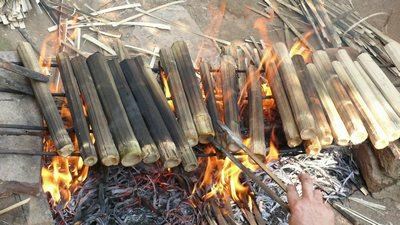



Lam rice in Hoa Binh is a traditional dish of the Muong people.
Lam rice in Hoa Binh is a traditional dish of the Muong people, associated with the ethnic culture, and it has existed for a long time and today it has become a cultural beauty in every meal on holidays and Tet. This dish is famous among the tourists near and far. Ms. Le Bich Thuy from Tay Ho district - Hanoi says: Every time I go to the Mineral stream in Kim Boi, I also buy Lam rice as a gift for my family and relatives. This is a delicious dish attracting tourists.
Today, Lam rice is not only available in Muong Dong (Kim Boi) but it is also available in many other areas such as in Tan Lac, in Lac Son, in Mai Chau... The people doing tourism in Ha Bi, now it is Kim Boi town (Kim Boi) say: For generations, Lam rice has existed in the life of the Muong ethnic group in Kim Boi. In the past, from the early days of the wild, from the fact that people had to go to the forest from early morning until late at night, they had to bring a little rice so that when they were hungry, they would cut bamboo tubes in the forest, put the rice and spring water in the grill, and it has become Lam rice today. For the people in Muong Dong in particular, usually the man is in charge of preparing the dishes in the family, but for Lam rice, both women, men and children know how to make it. They make Lam rice when they go to work in the fields, go to the forest to collect firewood, the children make it to eat while they are herding buffaloes. Up to now, the culture of making Lam rice still retains its value. Lam rice is simply a way to cook by using a bamboo tube instead of a pot, it is also a very rustic and unusual cooking method of the mountainous people. In the past, the people's production was associated with the mountains and forests, everything was simple, and the people thought of a new method of cooking rice, which was to put rice in a bamboo tube, light it on fire, and it was comfortable to bring it with.
With the time passing by, Lam rice has been processed more and more delicately. The chosen bamboo tube must be the bud, which is not too old or too young. As the aroma from the bamboo tube will blend with the aroma of the sticky rice when baking, creating the characteristic flavor of Lam rice. The rice is a famous upland sticky rice, medium grain, elongated, white and fragrant. The rice is soaked for 8-10 hours, then it is drained and put in a bamboo tube. When pouring the rice into the bamboo tubes, do not compress too tightly. Finally, use sticky rice leaves to roll tightly, seal the mouth of the tube and place it on the grill. In the past, the people used to bake Lam rice with firewood, but today they mainly use charcoal because it retains heat well and the rice is evenly well- done. The rice is baked for about 50 minutes, you must directly watch the fire and rotate Lam rice regularly, and keep the heat moderately. If you smell the aroma from the tube, it means that the rice is about to be well-done. Many people also create a way to marinate the natural flavor to make five-colored Lam rice, which is very strange and beautiful. Lam rice is a rustic dish, but it is dipped with delicious and rich sesame salt attracting the taste.
So far, Lam rice lam has become a commodity product provided at the provincial tourism attractions, bringing income to the local people. In the localities, a combination of rice production has also been established, both to exchange experiences in making the rice and to serve tourists from near and far. It can be said that Lam rice not only enriches the cuisine of the People of the provicial ethnic groups, but it also contributes to promoting Muong culture in Hoa Binh to tourists when they visit it.